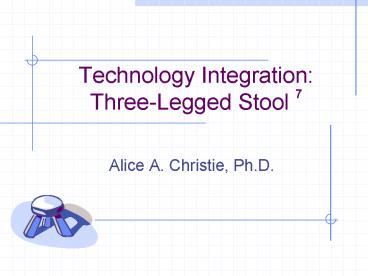Technology Integration: ThreeLegged Stool 7 - PowerPoint PPT Presentation
1 / 30
Title:
Technology Integration: ThreeLegged Stool 7
Description:
Technology Integration: Three-Legged Stool 7. Alice A. Christie, Ph.D. ... Why a Three-legged Stool? Three-legged Stool 7: Context. District. School. Administration ... – PowerPoint PPT presentation
Number of Views:339
Avg rating:3.0/5.0
Title: Technology Integration: ThreeLegged Stool 7
1
Technology Integration Three-Legged Stool 7
- Alice A. Christie, Ph.D.
2
Technology Integration Factors
Administration
Teachers
School
Projects
District
Context
Assessment
3
ISTEs NETS
- Teacher-centered instruction
- Single sense stimulation
- Single path progression
- Single media
- Isolated work
- Student-centered learning
- Multi-sensory stimulation
- Multi-path progression
- Multimedia
- Collaborative work
4
ISTEs NETS
- Information delivery
- Passive, receptive learning
- Factual, knowledge-based
- Reactive response
- Isolated, artificial context
- Information exchange
- Active, inquiry-based learning
- Critical thinking, informed decision making
- Proactive, planned
- Authentic, real-world context
5
Why a Three-legged Stool?
6
Three-legged Stool 7
- Context
- District
- School
- Administration
- Teachers
- Projects
- Assessment
7
Context
Healthy technicalinfrastructure
Supportivesocial climate
Healthy humaninfrastructure
8
District
Strongleadership
Technology useplan
Staffdevelopment
9
School
Knowledgeable,committed principal
Sufficientoperationaltechnology
Knowledgeable,willing teachers
10
Administration
Build effective human andtechnical
infrastructures
Understandtechnologycontext
Supportteachers
11
Teachers
Technologicalknowledge
Pedagogicalknowledge
Socialawareness
12
Projects
Existingpractice
Schoolculture
Existingresources
13
Assessment
Multiple Indicators
Authentic
Standards-Based
14
What are the OBSTACLES?
- Time
- Money
- Inflexible thinking by
- School Boards
- Administrators
- Teachers
- Parents
- Lack of a vision or plan
- Lack of teacher training
15
Moving Beyond Obstacles
16
Common Factors
- Schools view technology use as the glue that
holds the entire curriculum all together - Schools and school leaders emphasized learning
rather than focusing on the technology
17
Common Factors
- School are learner-centered, with emphasis on the
individual treatment of students according to
needs and capabilities - High ratio of classroom computers
- Looping
- Multi-grade classrooms
- Longitudinal electronic portfolios
18
Common Factors
- Schools utilize and emphasize curriculum
frameworks and standards to ensure that the goals
for student outcomes were clearly understood. - Teachers have input in curriculum framework and
strategies - Teachers share common planning time
19
Common Factors
- Schools have a density of computers that far
exceeds the average computer to student ratio - Schools undertake focused short- and long-term
planning - Schools have a big-picture vision of technology
uses in classrooms - Vision is reflected in long-term Technology Plans
20
Common Factors
- Classroom structure and layout reflect the new
paradigm - Lengthened class periods
- Interdisciplinary programs
- Project-based learning
- Buildings and classrooms designed to facilitate
and exploit the use of technology
21
Common Factors
- Schools seek external funding
- Chapter I funds
- Bonds
- State-funded initiatives
- Federally-funded initiatives
- Private sector funds
- Partnerships with corporations/businesses
- Small and large grants
22
Common Factors
- Schools make initial investment to defray the
exceptional costs of startup - Technology hardware
- Technology software
- Technology infrastructure
- Teacher training
23
Common Factors
- New Roles for Teachers
- Facilitators
- Coaches
- Guides-on-the-Side
- Midwives
- Curriculum Developers
- Information Producers
24
Common Factors
- New Roles for Administrators
- Mentors
- Teacher Advocates
- Shared Decision Makers
- Learners
- Active Participants in School Culture/Life
- Innovators
- Visionaries
25
Common Factors
- School outcomes are described in rich ways
- Schools move beyond traditional accountability
measures and use multiple indicators - Student and parent engagement
- Job placement success
- School and classroom climate
- Attendance and behavior
26
Common Factors
- Educators believe that technology supports
improved instruction by - increasing students' perceptions that their work
is authentic and important - increasing the complexity with which students can
think and learn - dramatically enhancing student motivation and
self-esteem
27
Common Factors
- Educators believe that technology supports
improved instruction by - making obvious the need for long blocks of
instructional time - fostering greater collaboration, with students
helping peers and (sometimes) teachers - giving teachers additional impetus to take on a
coaching (not dispensing) role
28
Common Factors
- Annual per-student cost for technology in these
technology-rich schools between - under three times the average per student cost
- over five times the average per student cost for
all U.S. schools
29
Our choice ????
30
Contact Information
- Alice A. Christie, Ph.D.
- alice.christie_at_asu.edu
- http//www.west.asu.edu/achristie/
- http//www.west.asu.edu/achristie/cue/































